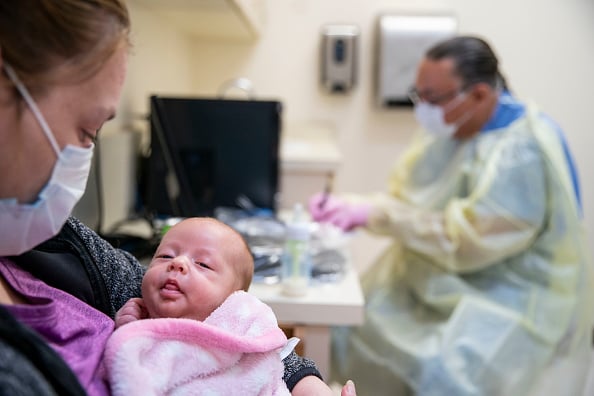Report On Business® Roundup: November Hospital PMI®

The Hospital ISM® Report On Business® for November featured a 6.5-percentage point increase in the composite PMI®, with boosts in business activity, employment, inventories and (once again) prices. A review of recent headlines reveals some of the reasons for those gains.
Respiratory syncytial virus (RSV) has slammed children’s hospitals and impacted an inordinate number of older people, and flu hospitalizations are at their highest level in a decade. Meanwhile, COVID-19 remains very much with us, and the seven-day average of U.S. hospitalizations of 36,433 on Wednesday is an increase of 29 percent in the last two weeks, according to data compiled by The New York Times.
Meanwhile, growth in elective procedures continued, though slow. As a result, many facilities stocked up on products and personnel, helping lift the Hospital PMI® to 57.5 percent. The previous two pandemic winters have been brutal for health-care providers, but Nancy LeMaster, MBA, Chair of the Institute for Supply Management® Hospital Business Survey Committee, said she believes hospitals are more ready for a surge this year.
Patient volumes rose from elective procedures *and* #RSV/flu cases, #employment and inventories were up, and prices kept impacting margins. Those details and more in the Hospital @ISM® Report On Business® for November; the PMI® was 57.5%. https://t.co/6q1a2Yfoi2 #ISMPMI #economy
— Institute for Supply Management (@ism) December 7, 2022
“The mix of flu and COVID-19 can both be treated similarly with the new antivirals,” LeMaster told a conference call of reporters on Wednesday. “The hope is that the COVID-19 cases that come into hospitals this winter will be less severe and won’t consume the same resources as in previous winters. The important factors will be how sick the patients are and how well the antivirals work.”
The X-factor could be RSV, LeMaster said: “It’s primarily a respiratory virus in children, so the pediatric hospitals filled up first. But this year, I’ve seen more cases in the elderly than I can remember in the time I’ve worked in health care.”
If the “tripledemic” caseloads are largely manageable, the increased traffic should be a business benefit to a hospital subsector that has been plagued by negative operating margins, though some for-profit systems have enjoyed recent improvements. In November, the Business Activity Index increased 10 percentage points to land north of 60 percent, and the Case Mix Index — which measures the shift in Medicare/Medicaid patients, for which facilities are reimbursed by the federal government — registered 57.5 percent, up 4.5 percentage points.
Perhaps most encouraging was a 9-point boost in the Employment Index, comfortably returning it to expansion territory. “My first thought was, ‘OK, where have these people been hiding?’ ” LeMaster said. She added that before the holidays — especially amid of economic dynamics like high inflation — many part-time or retired health-care workers take full-time jobs.
“We’re crossing our fingers that trend will continue, because it appears we’ll have a severe flu season this year, so (patient) volumes will be strong,” LeMaster said. “As November turned into December, there was nothing that would suggest a pullback in staffing, but we’ll see.”
Nurses at Kaiser Permanente facilities in Northern California won a 22.5-percent pay increase and increased staffing in a recently-ratified labor deal. Labor costs are measured in the Prices Index, which was north of 70 percent in November.
ISM Hospital PMI "respondents indicated greater ability to hire staff; this resulted in expanded capacity" positive for $HCA, $XHS, most providers. https://t.co/wLFI5EVFJ2 @HedgeyeEEvans
— Tom Tobin (@HedgeyeHC) December 7, 2022
The Prices: Pharmaceuticals Index was up 7 percentage points and the Prices: Supplies rose 3 points; both indexes remained elevated. Those readings are related to a 14.5-point jump in the Inventories Index, which returned to expansion. LeMaster said demand was up as many facilities boosted stocks of medications and such supplies as personal protective equipment (PPE) not only for a winter patient surge, but also before pharmaceutical companies reset their inventories in January.
“From the (Business Survey Committee respondents’) comments, there was concern about lab supplies; there will be a lot of testing for RSV, flu and COVID-19,” LeMaster said. “As these are also infectious diseases, we’re back to a need for PPE, masks and gowns.”
Another positive index development was the Technology Spend Index, which at 64 percent registered its second-highest reading ever, trailing only the 65 percent figure in November 2018. LeMaster said many facilities are investing in information technology (IT) for data collection, in some cases to make up for shortages of qualified human workers.
In case you missed the Report On Business® Roundup on the release of the November Manufacturing PMI®, you can read it here. The Roundup on the release of the Services PMI® can be read here. For the most up-to-date content on the three indexes in the ISM® Report On Business® family, use #ISMPMI on Twitter.


